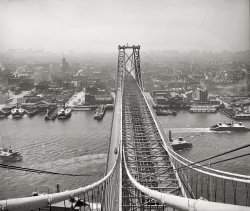
MAY CONTAIN NUTS

Search Shorpy
SHORPY ART

Framed or unframed, desk size to sofa size, printed by us in Arizona and Alabama since 2007. Explore now.
Join and Share
Ad-Free Shorpy
Shorpy is funded by you. Patreon contributors get an ad-free experience.
Learn more.

Recent comments
- If You’re Like Me, Never
- U.S.A.
- S&P
- 1940 Zenith radio model 6G601
- Quality goes in before the name goes on!
- Snazzy skirt
- Carbon Arc Lamps
- Illuminate us
- I remember it well
- I can't prove it
- Complicated then, forgotten now
- Bryan-Stevenson
- Skinny is as skinny does
- How do you rest in peace
- Riding the footboards
- Alas, hidden from view
- Baldwin Diesels
- Exclusive pump
- Bananas, Oysters and Smokey Joe
- Details, Details
- What's that building to the left of the tower?
- Coal Barges
- Bromo-Seltzer
- Inner harbor
- The Basin
- What a headache!
- Giant stepladder?
- Yeah, it was cold
- Love those coats
- Link & Pin Days Remnant
Member Photos
The Shorpy
Print Emporium
Print Emporium
Search Shorpy
Search results -- 30 results per page
- Cross-Country: 1915
- ... If it got to bad you could get out and push/pull the bike where a car needed a team of horses to get it out. Still, it makes my ... Posted by Dave - 04/06/2013 - 11:50am -
![Cross-Country: 1915 1915. "Baker and O'Brien, transcontinental motorcyclists, back of White House." Bud Baker and Dick O'Brien, whom we first met here. In May 1915 they embarked on a five-month, 10,000-mile jaunt to the West Coast via Indian motorcycle to see the California expositions. Harris & Ewing. View full size.
Hard to believe this actually happened....10 K miles, 5 months--1 K a week? Seems hard to believe--no headlight so no night riding; tires no good for the muddy roads they'd meet with after every thunderstorm; the stone exhaustion riding that unmuffled, suicide-clutched, barely-sprung boneshaker; the flat tires, the dust, the breakdowns.... Where are their goggles (they wouldn't get far without eye protection.) Where are their gloves? Where's their repair kit--that box on the gas tank won't begin to hold their spares? Where's their tent, gear, clothing, canteens? Apart from the breeches and puttees or gaiters and that snappy Indian pennant, they seem woefully unprepared.
[Not to belabor the obvious, but: This not during their trip. They lived in Washington. - Dave]
Cool Boys of the RoadAdmire these guys immensely. What an adventure. With a great masculine style. I'm fascinated by those shin guards. Modern armor for the modern man, very chic.
Handsome DevilThat one on the left is dreamy. I wonder if he's got a great-grandson...
Leather putteesThe "shin guards" appear to be standard-issue Army leather puttees, as used by the cavalry starting in 1911:
http://onlinemilitaria.net/shopexd.asp?id=3138
ArithmeticNot to further belabor, but 10,000 miles over five months works out to about 475 miles a week, or less than 70 miles a day.
Raindrops keep falling on my shin guardsIt's so late '60s, early '70s. This would have made a great property for Paul Newman and Robert Redford back in the day.
70 miles....70 miles a day on dusty, muddy, ungraded country roads or greasy city cobblestones. 70 miles a day on tires regularly puncturing. 70 miles a day over mountain passes with thin oxygen (check that carburetor!) and nighttime temps below freezing. 70 miles a day in Plains thunderstorms, desert dust (check that carburetor again, boys!), across skittery rail and trolley tracks, through piles of slithery horse poop. 70 miles a day without decent roadmaps. It would have been a grand odyssey, but I’d dearly love to know what actually happened.
If they were simply swanning around DC on their cherry Indian looking intrepid and not yet actually prepping to leave, fine, but I wish there were a later picture of them suited, geared, gauntleted, goggles, and ready to roll. I wouldn’t ride around the block dressed this way, sexy puttees or no.
Indian PowerplusDecember 1915 ad from a Kingston, Jamaica, newspaper that mentions the boys' trip.
Where's their book!?Dear Lord - what an adventure -- where's their book? I hope these two guys lived to enjoy enormous notoriety and maybe a few $$
Did they really make the trip? The suspense is killing this 76 y-o scooterist!
Amazing adventureIt was a different time. I saw a documentary about Indian cycles. One of the selling points of the early models including this one was its ability to go through muddy, nasty, rough road conditions where cars would be stuck. If it got to bad you could get out and push/pull the bike where a car needed a team of horses to get it out. Still, it makes my trip harrowing to 1000/1500 IBA ride to Colorado, Pikes Peak and points west last summer pale in comparison.
Right Write a book? Probably not though they more than likely wrote letters to their loved ones all along the route. It was a different time. Mail traveled by rail. Phones were in 30% of the homes. Tennessee wasn't electrified and these guys road rode two-up on a motorcycle across the same place where barely more than 50 years earlier the Poney Pony Express riders road rode.
I guess we all have hero's heroes. There's two more for my list.
William Crane
(The Gallery, D.C., Harris + Ewing, Motorcycles)](https://www.shorpy.com/files/images/05779a.thumbnail.jpg)
- Fasten Your Seatbelts: 1912
- ... turn by leaning to one side or the other, just like a bike.
Death Spiral I would just as soon share cigars with the ... Posted by Dave - 07/22/2012 - 6:58pm -
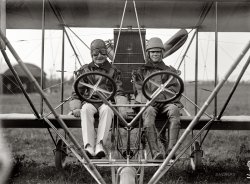
- Holiday: 1956
- ... our '55 88, two-tone greens! Here it is, with our tandem bike. This is at the very end of this car's tenure with our family, as it was ... Posted by Dave - 06/14/2012 - 4:59pm -
![Holiday: 1956 Somewhere in Southern California circa 1956. The car is a 1954 Oldsmobile. Another Kodachrome slide from my recent eBay find. View full size.
Wedding?Two guys in what appear to be tuxes... I wonder if the previous image was related to this event? The photographer appears to be proficient at fill flash.
Wedding bellsIn my opinion, this is the same lovely young lady who "loves olives" in a previous photo from the same lot of Kodachrome slides. It appears there is a wedding about to take place (men in tuxes in the background)and she is invited. Wonder if the groom is one of the guys at the previous party. Does anyone else feel like they are spying on people who don't know they are being watched?
Optional accessoriesThis is back when side-view mirrors, even on the driver's side, were extra-cost equipment.
Panoramic windshield1954 was the first year Olds had the wrap around windshield. They put them on the Chevy the next year.
Such a contrast!To the black/white/five shades of grey we see on today's depressing cars!
It's either a Super 88 or 98 because I can see stainless steel "top bows" in the roof. The turquoise and white car is a '55 Pontiac with first year V-8 and I believe the one on the left is a '55 Chevrolet. This was when GM ruled the road and every parking lot, like this one, held a majority of that brand. Their biggest problem in those years was to not get over 50% of the market otherwise they'd be charged with unfair trade practices! Today it's 17.5%, the lowest since 1922!
Two toningThe car is an Olds 98. The 88 and Super 88 had a different pattern of two-toning. My all time favorite of this period..
ExcellentFantastic era. Love the Kodachrome and the car. Makes you wonder who they are, and did that have a good life.
I miss Kodachrome.The colors hold up remarkably well for a nearly 50 year old slide. The magnificence of the late, lamented Kodachrome can not be understated.
[Or overstated. - Dave]
Facepalm!
One additional "trim" commentThe 1954 98 Holiday (hardtop, as posted) and 98 Starfire (convertible) did have the same "slashing" side trim. But the 98 sedan shared the trim arrangement of the 88s. I was always partial to the trim scheme of the 98 sedan, as it appears (to me) to complement the graceful lines of the entire car better, thus giving the overall design a more coherent look.
Beautiful CarI had a 1957 Olds Super 88 in my high school days in the early '70s. This picture brought back many memories.
KLN 961Another (blurry) view of the car. Click to enlarge. Bonus points to anyone who can Street View this.
Really hoping for an "Aunt Liz" momentMaybe someone will recognize this family.
The Side ViewThe lack of mirrors reminded me of my dad. Car racing brought so many innovations and safety improvements like rear view mirrors, side view mirrors, seat belts, and various safety glass and on, and on. He raced Midgets in his younger years, and all of our cars had side view mirrors because he installed them, or had them installed from the factory. And he installed seat belts too, well before they were standard equipment.
But then he also installed dual mirrors on my mom’s ’58 Chevy Impala convertible, the one with the 348 Police Cruiser engine, and she was often pulled over due to her lead foot for speeding. A very pretty Australian lady, and with that killer accent she was never given a ticket as I remember. Dad would always just laugh.
Mystery CarVictrolaJazz was correct about the '55 Chevy and '55 Pontiac in the background of the photo. The real tricky one to ID is the car in between them. It's pretty rough to figure out the make or model from just the "greenhouse" area showing ... I can't!
Oldsmobile!My family had the Olds dealership in Richmond California for many years. I have a few of the old dealer books, with fabric samples, loads of photos, accessory info, etc. But the best thing about the books is that at the back there are clear acetate (or plastic) images of all the models for the year, with matching cutout color swatches. You would go to the dealership and put together the colors you wanted - and where you wanted them. You would also select the upholstery you wanted. Then you placed your order and the factory would make YOUR car!
I really miss our '55 88, two-tone greens! Here it is, with our tandem bike. This is at the very end of this car's tenure with our family, as it was being replaced my Dad's $3 1961 Ambassador wagon (he bought it after it was totalled in a wreck and spent his spare time putting it back to perfect condition!).
My how things changeCan't help but notice how big the cars are and how small the houses in the background seem to be. Now the cars are much more compact (and efficient), but you could put two of those houses into the average new build today. But the families who lived in those small houses seem to manage.
CarsCars in large photo above:
The car in the middle of the two GM products looks like the top of a 1952-54 Nash. The dull window frames are a clue, Nash from 52-54 used a dull brushed aluminum on the window frames hence the lack of sun light twinkling from them.
Cars in KLN 961 comment:
The primary car is a 1954 Oldsmobile Ninety Eight. The car behind is a 1955 Mercury. The next car is a 1946-48 Plymouth (very subtle changes through those years) the one way back is a 1949 or 1950 Ford.
(Cars, Trucks, Buses, SoCal 1956 Kodachromes)](https://www.shorpy.com/files/images/SHORPY_Oldsmobile_Socal_1956.thumbnail.jpg)
- City Hall: 1905
- ... bicycles, but considering they had neither kickstands nor bike racks, but I can bring myself to overlook this.
The rowhouses look ... Posted by Dave - 08/05/2012 - 3:12pm -
![City Hall: 1905 Minneapolis, Minnesota, circa 1905. "Courthouse and City Hall." Look at the time! 8x10 inch dry plate glass negative, Detroit Publishing Company. View full size.
Looks the sameBut boy has the neighborhood changed!
The JailThat's Hennepin county jail, it might still be there. The proper entrance to the building has a quaint statue of a god, Poseidon perhaps, reclining on a cot.
TurnaboutThe view from the tallest tower on City Hall, in the direction of this camera location (on the top of the Metropolitan Building) is https://www.shorpy.com/node/6973. The state courts outgrew this Richardsonian building by the 1970s and moved a block south, and the jail moved a block east in 2001, but it remains the center of city governance.
A cathedral of governance!It embodies in stone the sacredness of democracy in the public mind at the time.
Love the beautiful frame houses in the neighborhood too - and it's charming to see the row houses.
Stone barrierIt's curious how there seems to be a barrier around 3 sides of the building. By the way it rises and hides 1st floor windows, it's on the higher-ground side. Perhaps a protection from water runoff? Yet there's a stairwell heading down halfway along it.
[The handy fence kept pedestrians from falling off the sidewalk into the light well as the street slopes up. - Dave]
His Left FootThe statue in the rotunda is "Father of Waters," sculpted by Larkin Goldsmith Mead. Legend says that rubbing his toe brings good luck. The left big toe is worn smooth.
Clean and symmetricalHave you ever seen such pristine sidewalks?? Or a better tribute to the stonemason?
Even the horses and carriages out front seem to be precisely arranged. Not so the bicycles, but considering they had neither kickstands nor bike racks, but I can bring myself to overlook this.
The rowhouses look like highly flammable Monopoly tokens.
I'm pretty sure this building was seen last year (pretty creepily in winter twilight) in "The First 48," a true-crime show on A&E.
TintinnabulationsWith such a beautiful tower as the crowning touch of this structure, I am curious if it included bells, if not for melodies, at least to mark the time. It appears there is some type of mechanism in the tower, but I can't make it out. Could any past or present residents of Minneapolis let us know if the tower chimed, and if so, does it still chime today? I am interested to know what was housed in the tower structure and if it is still in use. I certainly wouldn't pass up an opportunity to go exploring in this building from basement to pinnacle.
Peal outThe tower has a 15-bell carillon, and noontime concerts are still played. The bells also chime at the quarter hours. I don't know what the tower was used for, but a trip to the bell loft is unnerving. A tiny elevator and rickety stairs gets you to a beautiful view.
Look out! It's santa!That elegant tile roof was replaced not more than 5 decades later with some lame copper sheeting. When tiles cracked from the cold, they broke free and impaled pedstrians. Now you have to worry about giant icicles sliding off the copper all winter long.
And on another note, the "Father of the Waters" used to get all dragged out for Christmas. Frightfully so.
Beyond the BellsLongshanks is right - a wee slow elevator takes you up to the bells. Not recommended for the claustrophobic. You can walk if you wish; a tight, dusty, dim spiral staircase goes up to the chimes we well. But that's not as high as you can get: look at the full-size view, and find the tiny semi-circles at the peak of the tower. That's another floor, and they change the flag from those windows.
I've been up there. It was easier to get into East Germany in 1964 than to get into that space, but we did it - and to get down you have to walk backwards in the dark over a three-story void.
It's an amazing building. Just wish it wasn't puce.
(The Gallery, DPC, Minneapolis-St. Paul)](https://www.shorpy.com/files/images/4a12296a.thumbnail.jpg)
- The Apprentice: 1917
- ... I''m a bit rusty on setting type, but it's like riding a bike, you never forget. But I don't miss machine revises where you got covered ... Posted by Dave - 09/13/2011 - 4:17pm -
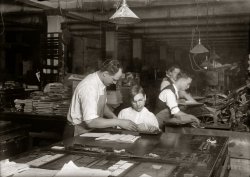
- Walton Way: 1905
- ... Elementary School through third grade. I would ride my bike down Arsenal Ave. to Walton Way and thence to school. The streetcar tracks ... Posted by Dave - 08/13/2012 - 6:57pm -
![Walton Way: 1905 Circa 1905. "Summerville, South Carolina -- Walton Way." 8x10 inch dry plate glass negative, Detroit Publishing Company. View full size.
Could be AugustaAs a lifelong resident (60 years) of Augusta, GA, I feel confident in saying this is indeed Walton Way. However, it's in Augusta, not SC. And, this particular section of it is in the "Summerville" neighborhood of Augusta. It looks as though we're looking down the familier steep hill where The Bon Aire Hotel and The Partridge Inn are both located at the bottom. As a matter of fact, The Partridge Inn can just be seen in the distance in the center of the picture. Of course I could be wrong...probably am.
Tree TownSo many trees to trim, so little time. Even though Augusta, Georgia has an average high of 58 and low of 33 in January, I am sure they can have an ice storm every now and then. I would guess that a heavy one would put this town out of business in 1905. Look at all the tree limbs over power, telegraph, telephone and even streetcar lines.
The tram is the only clueTried to find current pics of Walton Way. Only thing now in Summerville is Walton Place... a little cul-de-sac in a modern subdivision. But, close by is another development with street names such as Tram Blvd and Iron Road. My guess is that the area was bulldozed for new homes but the builder kept some of the history in the street names.
Ahhh, that’s better.Obviously the trollies clean-up after themselves in Summerville.
Too Late for Pony Express, Too Early for FedExOn the left, u-bolted to the metal post, what are those two box enclosures? Is the small one a Post Office mail drop? And I have no idea about the larger one.
Gould's Corner, Augusta, GAThis photo was taken from Gould's Corner in the Summerville historic district in Augusta, GA. The photo is listed in the LoC database at the end of a short series in Augusta; my guess is that the photographer simply labeled it "Summerville," then he (or someone else) later added the "S.C." based on the photos that followed. In any case, the house at the left is the Gould-Weed house. Just down the road, Walton Way takes a jog left, as can be seen by the curve in the trolley tracks. Here's the (overexposed) street view today:
View Larger Map
If you look at Bing's street view of the house from a few different angles, you can see that the architectural details match.
tree hazardsThough there is evidence of some tree pruning having been done, a lot of work remains to protect all those inmeshed utility lines from the next big wind storm and any swinging/falling branches.
MislabeledI suspect this photo is mislabeled. In Augusta, Georgia, there is a community also called Summerville. Walton Way, in the former place, is a major main road and vintage photos show trolleys were in service there. To my knowledge, my native Summerville, South Carolina never had trolleys.
Relay@lesle: The bigger box if possibly a postal relay box, to "refill" the letter carrier's sachel with delivery mail along the route. If not, then my guess would be garbage can. I agree with you about the smaller box being a mail drop box for customers.
Today it costs millions ofToday it costs millions of dollars a mile to build a light rail system. Back then they just laid down track and drove the cars on it.
Corrections and reflectionsAs others have noted, this Summerville is a section of Augusta, Georgia, on The Hill, as locals say. This is a view of Walton Way, corner of Milledge Rd., looking toward downtown (roughly compass east). The house on the corner at left is still standing, nicely restored in recent years. Streetcars (the preferred term in the South, not "trolleys") last ran in Augusta in 1937, four years before I was born there. My grandparents lived on the Hill, at 2504 Helen St. (house now demolished), and I attended William Robinson Elementary School through third grade. I would ride my bike down Arsenal Ave. to Walton Way and thence to school. The streetcar tracks were in the concrete pavement for many years after service ceased; in fact, you could trace practically the whole line back up to Monte Sano Ave. and, in the other direction, down the Hill to Thirteenth St. and then over to Broad St. From Monte Sano the line ran down Central Ave. in the center boulevard (in New Orleans they call it the "neutral ground') and worked its way back to Broad St. It was a belt line, i.e., cars ran in a continuous loop in both directions. Although I missed the streetcar era in Augusta, I later lived in New Orleans and rode them almost daily.
Definitely Augusta, my home townThe photo was taken at the corner of Milledge Road and Walton Way, looking e-s-e toward downtown. Growing up in Augusta in the 1940s, I distinctly remember the streetcar tracks on Walton Way, although the cars went out in 1935 on the Walton Way-Central Ave. belt line, and in 1937 on the rest of the system. Tracks remained on portions of Walton Way out to Monte Sano Ave., and on Broad St. out to 13th St. and from 15th out to Julian Smith Park. On Walton Way it was single track from Milledge to Monte Sano, and there was a turnout into the Arsenal. Trackage was standard gauge, T-rail (no girder rail, i.e., no flangeways). The original street railway here was the Augusta & Summerville Railway, Summerville being that portion of present-day Augusta known to the natives as "The Hill." My paternal grandparents lived on the Hill at 2504 Helen St. and I spent summers there with them well into the 1950s. Augusta was a great railroad town also, with the main shops of the Georgia Railroad located near the grand Union Station ("the depot" to the locals). All of that is demolished. The Southern, Atlantic Coast Line, C&WC, and the Ga. & Fla. also served Augusta. While I missed the streetcars in Augusta, I later rode them in New Orleans, and became (and remain) a trolley "nut."
Big box of news? Could that be an early paper vending machine, two cents for a copy?
Looks like AugustaI've lived in Augusta for 13 years now and as a resident and avid photographer, this defiantly looks like Walton way.
["Defiantly"? Definitely. - Dave]
(The Gallery, DPC, Small Towns, Streetcars)](https://www.shorpy.com/files/images/SHORPY_4a17061a.thumbnail.jpg)
- The Gas Menagerie: 1956
- ... rest of the "Memphis Mafia" showed up and he bought a new bike
for himself and the rest of the guys; as I remember it was an even ... Posted by Dave - 03/22/2013 - 1:51pm -
![The Gas Menagerie: 1956 Elvis Presley in 1956 at home in Memphis with his three-wheeled Messerschmitt "bubble car" and Harley-Davidson motorcycle, and grandfather Jessie Presley. Photo by Phillip Harrington for Look magazine. View full size.
Messerscmidt in the Parking LotWhen I was a kid living in Naples, Florida (late 1960s), I worked at the Publix on the north Trail. An elderly gentleman who shopped at our store drove one of these three wheelers, which looked to me to be made from aircraft parts.
My recollection was that his was deep red and cream colored, and it was beautiful.
MesserschmittThese cars were made at a time after the company was banned from making aircraft. One of many companies that made these types of cars.
Messerschmitt KR200The more common of the two Messerschmitt "Kabinrollers" - German for Cabin Scooters, so the classification as a motorcycle isn't too wrong - the other being the KR175. They were made by Messerschmitt until 1956 when the company was able to make aircraft again. At that point Messerchmitt sold the Regensburg factory to the car designer Fritz Fend who carried on production under the company name FMR.
I recall seeing one of these from time to time at a nearby supermarket, the last time being about 25 or 30 years ago now (I think, it might have been later). At the time it kind of blew my mind; a car from Messerschmitt that bore some resemblance to the cockpit of a wartime fighter plane, right down to the way that the canopy opened. It would have completely thrown me for a loop had I known at the time that the KR200 not only ran in a 24 hour time trial at Hochenheim but broke 22 speed records for cars of its class including an average 24 hour speed of 64 miles per hour.
Right on!Jim Page: Rumor has it that the canopies of the first ones actually were genuine left-over combat aircraft canopies. And those contraptions also owed some of their genesis to attempts to make some cheap form of individual transport for crippled veterans and paraplegics.
There was a "Heinkel Kabine" as well. Junkers Aircraft basically quit altogether, while the original Junkers & Co. is still doing well with gas heaters, as they have since 1895 (although as part of the Bosch Group now).
By the way, one nickname for the Messerschmitt was "Schneewittchensarg", or "Snow White's coffin" in English.
I owned one of these...after an Isetta. My best mate at the time had a Goggomobil) which he used to park up close to the front of my Isetta so I couldn't open the door to get into it! That wasn't the real reason for selling I it, I just loved the look of the Messerschmitt. Mine was cream and maroon and cost me £20 (US$30) secondhand in 1963.
InvestmentAmazing what these little beasties go for these days! Who knew they'd ever be worth above $50,000 for a restored example. Wonder where this one wound up?
Isetta!!!Loades, I owned an Isetta for about 30 hours. In this before-moving-to-Naples experience, a friend in Apalachicola, Florida, sold me his old pale-blue-and-white one for $50. A day or so later, when my dad found out, he made me return it. Frankly, by that time I wasn't sorry to see it go. That was enough time to realize that driving a tricycle car makes it almost impossible to avoid potholes in the road, and there were a lot of those in 1966 Franklin County, Florida! A month or so later, my dad bought me a used '65 four-door Corvair and I dearly loved that car.
Haven't Seen One in 50 YearsA classmate in Palm Beach Public School (FL) drove one of these in 1962. We were in 9th grade but it was apparently classified as a motorcycle allowing him to operate it. But then again it was Palm Beach where some laws were never enforced for certain people in those days.
Maybe not GrandpaThis is a wonderful photograph, of course, but I do not think this is Elvis's grandfather, Jessie Presley, but rather Dan Shackleford, from Tupelo, Ms., who was visiting the family when Phillip Harrington shot a number of photographs on Audubon Drive. Furthermore, Elvis gave this car to Colonel Tom Parker, his manager, who did not keep it. Thank you so much, Shorpy, for posting the remarkable pictures in this series! Alanna Nash, author of "The Colonel: The Extraordinary Story of Colonel Tom Parker and Elvis Presley" (Simon & Schuster, 2003)
[I am no Elvis expert but do note that the Web sites that put the name Dan Shackleford to the fellow on the left also misspell "Messerschmitt" and "Audubon" -- they do not impress me as being very accurate. -Dave]
Dave, duly noted. Grandpa Jessie lived in my hometown of Louisville. I have seen a number of photographs of him, and while it's true that this fellow somewhat resembles Jessie, I do not believe they are one and the same. I have seen at least half a dozen photographs of Jessie Presley, and he does not appear to use a cane in any of them. He also was quite a dandy, and loved to dress up. And in Phillip Harrington's original story for Look magazine, he identifies this gentleman as Shackleford. -- AN
The guy could buyI was working in Hollywood as a Triumph motorcycle mechanic when Elvis
and the rest of the "Memphis Mafia" showed up and he bought a new bike
for himself and the rest of the guys; as I remember it was an even dozen.
Alanna is correctSorry Dave, mispellings aside, Alanna is correct. The photo is with Dan Shackleford. In all fairness though there is a strong resemblance to his grandfather Jesse.
Triumphs@ Rip Tragle
Rip, I suspect that two of them are pictured here.
(The Gallery, Cars, Trucks, Buses, Elvis 1956, Memphis, Phillip Harrington)](https://www.shorpy.com/files/images/SHORPY_Elvis_Presley_1956_90.thumbnail.jpg)
- Paper, Mister?
- ... early-mid fifties and only did it for money to support my bike. It taught me to be self sufficient, if I wanted something, I worked for ... Posted by Dave - 08/10/2010 - 11:38am
- Manley Boy: 1917
- ... in 1903.
Track Stand It looks to me that Manley's bike isn't in motion, that he is executing a "track stand," a technique in which a rider balances his bike with little to no forward motion. His pedal cranks are horizontal and the ... Posted by Dave - 05/04/2018 - 11:31am -
![Manley Boy: 1917 March 15, 1917. Oklahoma City, Oklahoma. "Manley Creasson [Creason], 914 West Sixth Street. Messenger #6, MacKay Telegraph Co. Says he is 14; school records say 13. Says he has steady job -- 'Been a messenger for years. Get $15 for 2 weeks' pay'." Silver gelatin print by Lewis Wickes Hine. View full size.
Hard LifeIf my Ancestry.com research is correct, Manley died in 1941 at the age of 38 in Dallas, after serving some time in Leavenworth Prison in the 1930s. In the 1930 census, he is shown as a married boarder, with no job.
A Manly Man, to the EndManly R. Creason (the correct spelling) was born in, either, 1902 0r 1903, depending upon which account is correct. He died in Texas in 1941 of tuberculosis
The School was Wrong (at least according to the State of Texas)If you go by his death certificate issued in Texas in 1941 (he died from pulmonary tuberculosis at the age of 38).
As per the 1940 census he and his wife, Jewell, were the owners of either a cafe (1940 census) or a 'recreational club' (death certificate).
That said, his census records each have him listed as being born around 1904, so perhaps Texas was wrong after all.
They had a daughter, Mary George, and Jewell lived until 1985, apparently never remarrying as she retained her maiden name according to her record in the Social Security Death index.
Birthdate According to his headstone he was born in 1903.
Track StandIt looks to me that Manley's bike isn't in motion, that he is executing a "track stand," a technique in which a rider balances his bike with little to no forward motion. His pedal cranks are horizontal and the front wheel is turned slightly, which is the signature look of a track stand.
AwesomeThat's what my son said when I shared this Shorpy with him this AM. He's a bike messenger in Chicago and has shared it with everyone at work!
Reliability of Information on Death CertificatesA deceased person's vital statistics on a death certificate are usually provided by an informant. The informant may be anyone, such as a relative or a neighbor.
Those vital statistics, such as birthdate, may therefore be subject to error as informants may not be able to provide accurate data. Even spouses don't always know the correct birthdates or birth places for their mates.
The medical information on the certificate is usually provided by a doctor or some other medical official.
In the case Mr. Creason, I would tend to think that the birth data provided by the census is probably closer to the truth than that given in the death certificate. He may have given the birth information himself.
(The Gallery, Bicycles, Kids, Lewis Hine, OKC)](https://www.shorpy.com/files/images/SHORPY-04020u.thumbnail.jpg)
- Marfak Lubrication: 1960
- ... to the restroom after a spicy lunch and the guy on the bike in front of the Service bay is learning where the muffler's located. The ... Posted by Dave - 06/06/2022 - 12:00am -
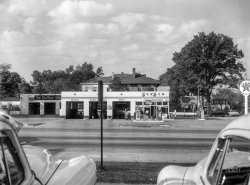
- Chautauqua: 1890s
- ... lake has a beach with sand, there are numerous trails and bike paths but it is indeed a built up community of homes. Performers worked in ... Posted by Dave - 12/13/2016 - 5:34pm -
![Chautauqua: 1890s New York state circa 1890s. "Assembly hall, Chautauqua." Which was not just a place but a movement. Glass negative by William Henry Jackson. View full size.
Uncomfortable SeatsThose hard wooden benches look as uncomfortable as the wooden chairs that are in the Great Auditorium in Ocean Grove, NJ which was built in 1894!
One lonely soulall the way up in the nosebleeds.
ChautauquariansThe Chautauqua Institution is still active and has an online presence:
http://www.ciweb.org/historyarchives/
Education for everyoneNineteenth-century Americans valued education. The Chatauqua movement joined the earlier Lyceum movement, mechanics' institutes, agricultural extension, and land grant colleges in an attempt to bring education to as many people as possible, at any point in their lives. Public radio and television have tried to extend the success of these pioneering institutions.
[And it was motion pictures, the phonograph and radio that helped bang a lot of nails into the Chautauqua movement's coffin. - Dave]
VestigesThere were Chautauquas in many places. I live in the remnant of one near Carlisle, Ohio (which is to say, the middle of nowhere).
Great sound system!I'm not an engineer, but it seems to me this hall was designed with sound in mind. As well as being a platform for a speaker or small musical group, the stage would also have projected sound up to those reflective wooden ceilings. I bet you could hear a whisper from the stage anywhere in that hall. This, plus the circular arrangement of the benches (or pews) would have contributed to an intimate experience for both audience and speaker.
And don't miss the massive organ.There is a wonderful pipe organ custom-built to work with this stage. A highlight from two years ago was the showing of a silent movie starring Zasu Pitts while a talented and energetic organist played the complete original score, accompanying the movie scene-for-scene.
Ocean GroveThe Ocean Grove Auditorium is the kid brother of the Amphitheatre in Chautauqua. The designers took all the details of the original, and adapted it to their location. Almost identical capacity. The one in Chautauqua is built in a natural ravine, whereas the one in Jersey is on the beach. So they tucked the sides in a little and put a balcony all around. The Ocean Grove one has all natual finish on the wood, which makes it look like the inside of a cello, just gorgeous. Chautauqua has that wonderfully drab yellow paint. Ocean Grove has a 10,000 pipe organ. A toss up as to which is better, they're both great venues for a concert.
Sound system not requiredI saw Ethel Merman in what I believe was that same outdoor auditorium in Chatauqua, NY, in the summer of 1977. The sound system wasn't working, but of course with Ethel Merman that didn't matter. Chatauqua at the time was a picturesque vacation town packed with beautiful old houses. I expect it still is.
I've performed on that stageI performed here in my youth as part of an all-county high school orchestra to an absolutely packed house. Picture "The Battle Hymn of the Republic" during a raging thunderstorm.
Chautauqua vs. Ocean Grove, NJ AuditoriumJazznocracy,
Thanks for adding the history about the two venues and their designs. I'm attaching a photo of the Great Auditorium in Ocean Grove, NJ that shows a better view of the design.
American OriginalI'm guessing that this is the original Chautauqua venue in upstate New York. Chautauqua later became a generic name for the traveling tent shows that criss-crossed America during the summers. They featured musicians, jugglers, singers, yodelers, storytellers and always finished with inspirational speakers who's most frequent topics were positive thinking and how to accumulate wealth. They were extremely popular, especially in rural America, and drew capacity crowds.
Still kickingI went to Chautauqua Institute with my exwife's family one summer. A gated community in which private home owners rent their houses to visitors for weeks at a time. The Institute had weekly programs featuring a theme, and lectures, art exhibits and performers were all booked to support the theme. The lake has a beach with sand, there are numerous trails and bike paths but it is indeed a built up community of homes. Performers worked in the open air theatre/amphitheatre and it was really interesting and quaint. The biggest drawbacks were the mosquitoes and black flies.
ChautauquaChautauqua is a wonderful, magical place. The PERFECT place to spend a summer! Check it out!
Totally gone now!This building is now totally demolished. The Institution decided they needed an entirely new structure to go ahead into their next couple of centuries, and has raised it to the ground. They are now building a new "Amp" that will have an orchestra pit that rises and lowers, enormously improved backstage facilities, and many other features. The roof line will be virtually identical, and it will hold about 500 more people. MUCH brouhaha over this project, which I will sidestep.
Here is a webcam that shows the project's progress.
http://ciweb.org/amp-cam
(The Gallery, DPC, W.H. Jackson)](https://www.shorpy.com/files/images/4a03966a.thumbnail.jpg)
- Fix-a-Flat: 1937
- ... replaced with something that didn't work.
This causes bike riders today to carry a spare tube instead of a patch kit.
Deja vu ... Posted by Dave - 01/27/2015 - 8:49pm -
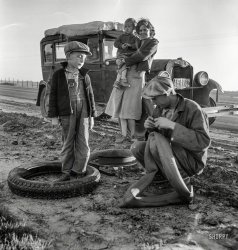
- Detroit: 1897
- ... guys, I couldn't resist this one, I just went out on the bike to get an "after" photograph of this view. Enjoy!
... Posted by Dave - 08/20/2012 - 10:22am -
![Detroit: 1897 Circa 1897. "Post Office, Detroit." Sign on utility pole: "Please do not spit on the sidewalk." 8x10 glass negative, Detroit Publishing Co. View full size.
Not in AustinThe ones in Austin were built in Indiana.
[They may have been manufactured in Indiana, but, as noted below, they were purchased used by Austin from Detroit. - Dave]
1892From the woman's attire in the right background, (white blouse, dark skirt--not quite in an "A" line, probably a boater hat), I guess that this was taken in 1892. If she is not quite in fashion, then 1893.
Moon tower!That looks exactly like one of the "moonlight towers" of Austin, Texas -- and according to Wikipedia, they were purchased used from Detroit in 1894. I wonder if that's one of the ones residing in Austin now.
Fort and ShelbyThe old post office in Detroit was on the northeast corner of West Fort and Shelby. Nothing in this photo remains today.
Alright, alright, alright ..."Party at the Moon Tower."
Sidewalk Sign EnvyI would like to time travel and swipe some of the polite requests to refrain from spitting on the sidewalk, and bring them to current day Boston to be posted. The sidewalks are covered with spit and gum, and there is nothing quite like walking behind a spitter. That is particularly true on a windy day.
Back to the photo, the post office is magnificent! I wonder if it had spittoons inside.
A short tripSeems ironic that there should need to be a letterbox across the street from the world's largest post office.
High SteppingWhat's with the man high stepping in the street, a block back?
[He's getting on a bicycle. - Dave]
Smooth pavementI can't help feeling a bit of envy by looking at that smooth pavement on the street. Notable that this was taken at a time when the automobile was still considered a fad, a mere toy for the idle wealthy, and was not still being used as a regular means of transportation.
Federal BuildingThere's quite a history of this place, as well as more photos, over at:
www.buildingsofdetroit.com/places/post
M.O.S.W.Looks like John Cleese doing his Silly Walk in front of the library.
It is quite odd to find nothing at all remaining from this wide swath. Many buildings from this era are still in place - any drive through Detroit shows that.
Then & NowHey guys, I couldn't resist this one, I just went out on the bike to get an "after" photograph of this view. Enjoy!
http://www.flickr.com/photos/gsgeorge/3935273602/
(The Gallery, Detroit Photos, DPC)](https://www.shorpy.com/files/images/4a05298a.thumbnail.jpg)
- Postal Boys: 1911
- ... was taken, they weren't ubiquitous yet, but the second bike from the right does appear to have some kind of band on the left rear ... arm...
recycled board racers? Except for the center bike with the auto horn and spring seat, these bikes look like they had earlier ... Posted by Dave - 08/13/2013 - 3:59pm -
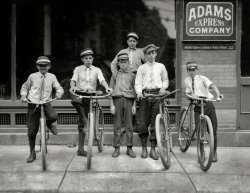
- Uncle Don: 1973
- ... us is "the field" we got to play in and make trails and bike ramps and forts. In the extreme left near the horizon line is a corn ... Posted by delworthio - 09/12/2011 - 5:49pm -
![Uncle Don: 1973 It's Uncle Don (last seen here 10 years before) in our backyard in Rochester, Indiana. My brother is wearing one of those groovy new smiley face T-shirts. Behind us is "the field" we got to play in and make trails and bike ramps and forts. In the extreme left near the horizon line is a corn field. Next to that is a barn full of tractors and antique cars. As I recall there were some foreign sports cars, too. Kodachrome slide with a date stamp of June 1973. View full size.
InterestingVery interesting. I actually like this pic. It reminds me a simple lifestyle that I sometimes yearn for. The little girl on the far left in the long red dress reminds me of the way how the Amish dress their children.
And the Oscar goes to...OK, the truth finally comes out. You lived your life in an MGM musical directed by Vincente Minnelli, designed by Cecil Beaton and photographed in Technicolor, right?
Heretics!No, Dave, my parents were Orthodox Agfachrome.
For some reason...This reminds me of "The Sound of Music." I'm not sure why -- maybe it's the girls who are dancing in the foreground.
The World Is a Carousel of Color..."Wonderful, wonderful color!" I don't know, I was around in 1973 (and about the same age as these kids), and I don't remember any photographs looking this color-saturated. Maybe the color got "bumped up" somehow, when it was scanned? It's still charming, nonetheless.
[Evidently your parents didn't believe in Kodachrome. - Dave]
Okay You Got MeYour suspicions will be confirmed when you see the next slide, tterrace.
Year of the maxiThe little girl on the left is very fashionably dressed for 1973. Maxi dresses were the rage for a brief moment. They were banned at my middle school because girls were tripping on their hems and tumbling down the stairs.
Finally, someone younger than me!This is the first of the old photos that actually has folks younger than me (well, maybe just two of them; I'd have been in that play group, at 7 years old. And I'd have been wearing clothes just like the kid in the middle in the game of keep-away.... he even looks a bit like me at that age!)
Reminds me of some of the family reunions we had when I was a child. Good times with family!
Thanks Del!
Time warpHey, wait a minute. This site is for old photos. 1973 was only a couple of years ago, right?
Rules, Rules, Rules"Hey, wait a minute. This site is for old photos. 1973 was only a couple of years ago, right?"
I guess this person missed the "Always Something Interesting" part of the webpage.
Interesting how some people think that there ought to be strictures to a photo website, can't they just enjoy something new and interesting? Nope, it's all rules and regs to them.
I'll let someone else remind them that 1973 was actually 36 years ago, which is older than a lot of people online out there. Younger people (gasp) might have an interest of a slice-of-life from before they were born, whether its 1873 or 1973. Imagine that!
[Well you know, that comment saying 1973 was just a few years ago -- that's what you call tongue-in-cheek. - Dave]
Another piece of AmericanaI'm surprised that nobody has commented on the piece of Americana that has virtually disappeared from modern society -- the "trash burner" at the edge of the lot. Those were immensely popular back in the late 50s - early 70s as a way to dispose of combustible household waste. Sears sold a model similar to the one shown through their catalog. It had a cone-shaped top with a heavy wire mesh to contain burning embers, and there were holes down near the bottom to promote upward airflow to provide efficient combustion. The "barrel" unhooked from the bottom to allow removal of the ashes. Awareness of environmental considerations in the 70s soon made these fixtures of suburban American life a thing of the past and today most incorporated areas ban any kind of burning of trash. Those few who insist on burning their trash use 55 gallon oil drums with the top cut out, much to the consternation of their neighbors.
Surreal compositionAlmost takes of the dynamics of a Georges Seurat painting in composition. Everyone is engaged in some manner and positioning is very nicely balanced. Really a beautiful photograph.
[Plus the subjects are kind of pointillated. - Dave]
Tongue In CheekYes, 1973 yeah I showed my humorless edge there, sorry sorry sorry...I will try not to do that again....!!!
Sorry!
Hairdo Hand Grenade My eye went directly to the trash burner when i saw this photo. I couldn’t help it. It made me remember how satisfying it was to ignite a big bag of trash and after a good blazing conflagration was achieved throw my mother’s empty cans of aerosol hair spray down the nosecone and wait for them to explode. Ahhh, the joys of childhood.
YarnNotice the little girl has a yarn hair tie. I had forgotten how popular those were -- we bought bundles of them at the drugstore in different colors.
(ShorpyBlog, Member Gallery, Kids)](https://www.shorpy.com/files/images/img0050__0.thumbnail.jpg)
- Fayetteville at Five: 1941
- ... that results in limited street parking, narrower roads, bike lanes, pedestrian priority rights-of-way, etc. But I can't help but ... Posted by Dave - 10/04/2021 - 1:13pm -
![Fayetteville at Five: 1941 March 1941. "Traffic on the main street of Fayetteville, North Carolina, at about five o'clock, when the workers start coming out of Fort Bragg." Photo by Jack Delano. View full size.
What's he standing on?Is what he's standing on still there?
[Planet Earth? Last we checked, yes. - Dave]
Twist of FayettevilleThere have been a lot of changes in downtown Fayetteville. This looks approximately right - Rayless department store was at 200 Hay St. There is no more parking, and the street has been narrowed with many trees planted. I can spot at least 3 surviving buildings on the right, including the old McFadyen Music.
It looks like the original photo was taken from the balcony of the Market House. You can see it in street view if you swivel 180 degrees.
Is that a Lincoln?The fifth car back on the left, the light-colored one. I need help from the Shorpy auto buffs.
I have lived here since the 70sYes, he will have been standing on the west balcony of the Market House, it was recently in the news due to an attempted arson during the riots last summer. The debate is still open as to what should be done with it, tear it down, move it, or?
I remember many of the buildings in the picture, many started going away by the late 70s and early 80s as the downtown area fell apart and shopping moved out to the malls. Quite a few of the buildings are still there but heavily renovated. The Hotel Lafayette is long gone, The Prince Charles is still there and is currently housing rental condos and small businesses. Downtown has come, gone, and come again.
My guess is ChryslerI'm thinking this is a 41 Chrysler Series 30 Eight
5th car on leftI don't believe so. The Continental had a different trunk lid and rubber mudguard on the front of the rear fender, and the Zephyr rear was more sloped. Could be wrong though.
5 p.m. Fort Bragg exodus?I lived on Fort Bragg when my dad was stationed there in the early '60s and it's highly unlikely any end-of-the-day traffic from the post would be noticed in downtown Fayetteville 13 miles away.
[Fayetteville was home to thousands of construction workers engaged in a massive wartime expansion of Fort Bragg -- the reason this series of photos was made. - Dave]
No, it's not a LincolnThe shape of the rear fender, the three horizontal ribs, and the location of the filler cap leave no room for guessing – it's a 1941 Plymouth P12 Special Deluxe.
McFayden MusicI was a little surprised to find out that McFayden Music is still in business, though now they are in Greenville, according to their website!
Fayetteville Street LifeI suppose the trees planted along the sidewalk in present-day Fayetteville are nice, and I know there is an anti-automobile sentiment in many towns, large and small, that results in limited street parking, narrower roads, bike lanes, pedestrian priority rights-of-way, etc. But I can't help but notice the vibrancy of street life in Fayetteville back in 1941. The streets are lined with shops, and there is exuberant signage everywhere. There are actual pedestrians - shoppers, workers, people running errands - walking on the sidewalks. The street is bustling with traffic. Today? It looks kind of quiet and desolate - although I bet the local shopping mall and the Wal-Mart and the Home Depot out by the Interstate are full of consumers.
(The Gallery, Cars, Trucks, Buses, Jack Delano, Stores & Markets)](https://www.shorpy.com/files/images/SHORPY-8c04841a.thumbnail.jpg)
- Western Electric: 1917
- ...
Could it Be? A C 1909 Harley V Twin?
(The Motor Bike that is. Thanks Everyone. I just knew Shorpyites would have the answer.) ... Posted by Dave - 03/21/2016 - 12:46pm -
![Western Electric: 1917 Oakland circa 1917. "Western Electric Co. -- looking east toward Pacific Tel." For more than a century, the company was the manufacturing arm of Bell Telephone. 8x6 glass negative by the Cheney Photo Advertising Co. View full size.
In the next photoThe wagon, motorcycle, and both cars are involved in an accident. Shorpy taught us this is what happens in Oakland.
The Parapets are Adorned -...with barrels of vegetation, mayhaps to soften the harshness of the stretch metal screens on the windows?
[Sand-filled barrels were placed atop factory roofs for use in case of fire or cartoon violence. - Dave]
Could it Be?A C 1909 Harley V Twin?
(The Motor Bike that is. Thanks Everyone. I just knew Shorpyites would have the answer.)
Ma BellThey built good stuff. I miss the old Bell System, monolithic and overpriced as it was. Now, we have fiber to the home, Skype, too-cheap-to-measure worldwide communications from a pocket phone. All of which was unlikely under Ma's loving embrace (remember Picturephone?).
But Ma brought us UNIX, the cellphone and Telstar.
Thanks, Ma, for getting us started.
Built to LastI still use my 40 year old Trimline Touchtone in my home office. Built like a tank in the USA (until the early 80s and the breakup) and lasts forever. I get the same tactile satisfaction from it as when I use my Nikon and Canon F bodies.
No job is so importantFrom OSPMAG.COM:
The telephone industry has always stressed safety from Day One. From the earliest days, the telephone company was safety-minded. Throughout the Bell System, this motto was displayed everywhere:
"No job is so important and no service is so urgent that we cannot take time to perform our work safely."
I do remember the signs, and we had mandatory "safety meetings" every month.
Western Electric became AT&T Technologies 1984, Lucent in 1996 and then was et up by Alcatel (France) to become Alcatel-Lucent. Their stuff was legendary for reliability, though some thought it a hidden "profit center"' for rate-regulated AT&T.
Built to last and they haveI still use 1960s Western Electric phones for our (hardly used) land lines. The wall phone and desk phone were whatever models first had the # and * on the touch pads.
Yet, in this iPhone age, I still keep my old baby-blue Cap'n Crunch whistle in case it all goes South.
The motorcycleThe flat box on top of the fuel tank, the box behind the engine, and the engine shape make it look to me like an early Indian, like this one:
Could it be? NoThe motorcycle in an Indian v-twin
Mystery locationDoes anyone know where this is? I've trolled all kinds of old manuscripts via Google and can't find any reference to where this exactly was.
Beyond the HarleyThe two cars look to be a 1916 Dodge and a 1915 Type B Saxon
1912 IndianThe motorcycle is a 1912 Indian TT Model, so named for the marque's 1-2-3 place finish in the 1911 International Isle of Man Tourist Trophy race. It can be identified by the straight-down exhaust pipe coming out of the front cylinder. The photo below is of a two-speed model (the shifter is on the top frame tube where it starts to slope downward), and shows the exhaust routing that was unique to the 1912 Indian V-Twin. The long lever with the ball on top controls the clutch—despite factory advertising, not all of the 1912 production bikes had one.
The 61 cubic-inch engine developed 7hp and in racing trim could power the cycle over 80 mph. This year Indian Red paint became standard, although Royal Blue could still be ordered as an option. Other new features on the 1912 Indian were no more bicycle pedals, an extended front fender, an improved coaster band brake, footboards, and the first kick-starter (forward throw) as seen in the bottom photo of a single-speed version that—except for the luggage rack—matches the motorcycle in the main photo.
Location, etc., etc.At the time this photograph was taken, the Oakland branch of the Western Electric Company was at 1900 Telegraph Avenue. Pacific Telephone and Telegraph is behind this building—a block east and half a long block south at 1751 Franklin Street.
(Technology, The Gallery, Factories, Motorcycles)](https://www.shorpy.com/files/images/SHORPY-924A.thumbnail.jpg)
- Looking Toward Liberty: 1912
- ... last time that you saw a person with a suit on riding a bike.
(The Gallery, DPC, Stores & Markets) ... Posted by Dave - 08/15/2012 - 2:38pm -
![Looking Toward Liberty: 1912 Poughkeepsie, New York, circa 1912. "Main Street looking toward Liberty." A few years after our previous visit, things have been spruced up a bit. 8x10 inch dry plate glass negative, Detroit Publishing Company. View full size.
An interesting conceptDoctor Foote the dentist!
Notice the time travelerBut, but, but ... he CAN'T be talking on his cell phone in 1912.
[Back when cellphones were invisible. - Dave]
Boaters and BowlersOh, to be back in the age of hats.
LightingThe arc lights of old have been supplanted with incandescent ones. The lighting must have been much less harsh as a result.
Dr. Foote If only he had gone into chiropody rather than dentistry. Imagine the brilliant career he could have had!
Riding against trafficMany years ago I was taught to ride my bicycle against traffic. This was the late 1940s and the instructor was a crusty old Boy Scoutmaster. I've never heard that advice again.
I note in this image that the bikers are riding in the far outside of the lanes and against traffic. Of course this may just be an artifact of this photo. Or, in fact, in the days of horses and street cars it was the safest way to go.
Looks more likePookeepsie.
I think I found itI was a bit obsessed with this one because it seems many of these gorgeous buildings are still standing. The brown tower in the street view seems to be the former location of Elting's children's clothiers. The "1872" building across the street seems to be getting renovated. Way to go Poughkeepsie!
View Larger Map
GhostsBesides the man who's not talking into his invisible cell phone, did anyone catch the woman on the bottom left who is surprised to witness the reflection of a man who is not on the street near her? He certainly isn't inside the building. And that glass is flat.
[He's right behind her on the sidewalk. She wouldn't be able to see his reflection. - Dave]
Pookeepsie: and it's still funny!Back in the old Vaudeville circuit days there was a list of towns known to every comic that by simply mentioning on stage would make the audience howl. Why? No on knew, but it worked! Poughkeepsie was one.
Dave says: "spruced up", which is true enough. But fast forward to the sixties and the genius-bar running the city decided to draw business back into the downtown area from the outlying shopping centers by paving over Main Street into a pedestrian walkway with ugly cast concrete
planters and benches cast willy-nilly along the way to add to the luxurious ambience of what was a total mess.
This led to the complete demise of downtown business and the stores large and small fell like dominoes. I have been back there recently and the "Main Mall" has been removed and, credit where it's due, things are looking pretty good.
However, don't let me get close to starting on the east-west "Arterial Highway": built on the cheap using city streets and ruining perfectly good neighborhoods.
Dental teasingFoote in mouth.
Cell enlargementHow did you get such a smooth enlargement? I couldn't achieve this with CS5.
[I used the original image, which is about four times the size of the hi-res image posted here. - Dave]
When was the last timethat you saw a person with a suit on riding a bike.
(The Gallery, DPC, Stores & Markets)](https://www.shorpy.com/files/images/4a25724a.thumbnail.jpg)
- Mobilized: 1940
- ... me? I love my job! - Dave]
Look Ma, No Hands The bike on the right is missing its handlebars! Theft prevention, or did the rider ... Posted by Dave - 07/22/2019 - 1:46pm -
![Mobilized: 1940 December 1940. "Soldiers on street corner in Starke, Florida. Boomtown in defense district." Medium format acetate negative by Marion Post Wolcott. View full size.
Piss off, Indeed (Plus added information)Dave,
That guy is wacko. I'm on your side.
My mother-in-law was a St. John and I thought this might be family. Not to be though.
The Western Auto owner, Vincent Selleck St. John, was born in Connecticut in 1892 and died in Florida in 1970.
The soldiers were from Camp Blanding located about 9 miles NW in Clay County. My father was inducted into the Army there in 1945. I served in the Army Reserves and attended several weekend training exercises at Camp Blanding.
Kansas City IconThe iconic sign in downtown KC was restored to working order on July 13th, 2018. The building now houses residential lofts.
[I love my job! - Dave]
Piss off!Gee, I'm glad I only purchased 2 of your overpriced prints before realizing what an asshole you are, Dave!
[So you post a comment about Kansas City under a photo of Starke, Florida (along with the inexplicable attachment of a cable TV contract) and you're complaining about me? I love my job! - Dave]
Look Ma, No HandsThe bike on the right is missing its handlebars! Theft prevention, or did the rider really ride without them?
By the numbersI'll say this one time, you two. Don't make me count to three.
Takes me back, though not so farI worked for Western Auto for 6 months while waiting to be drafted in a later war.
Other sideMy late father used to tell me the way to tell which side of a car the battery was on by looking which side the tailpipe was on. Batteries don't like heat so it was placed opposite where the exhaust manifold was. This only applied to inline engines.
I never asked him why that information was valuable.
Western Auto Will Soon Be GoneThis corner (100 W. Call St) will soon change. Evidence?
Old view -- (different angle) http://cinematreasures.org/theaters/33980
New view -- http://cinematreasures.org/theaters/21944/photos/22406
At least the Western Auto was replaced by a cool moderne movie theatre, and that place is still showing movies.
Western AutoFor my friends and me, the Western Auto was like the new car showroom for bicycles. We were regulars there, looking, kicking tires, beeping horns, being mesmerized by all the chrome, lusting over the Stewart Warner Speedometers and wishing we had one of those big bullet headlights on our bikes.
About This Photograph ... In Groups of TwosThe two men leaning up against the building, left of the front door, appear to be father and son. The identical position of their mouths makes me believe they are making the same statement to the men and boy walking past them.
There is an interesting comparison/contrast between the two soldiers staring at the camera and the two men at far right. Only one of the four is not holding a cigarette, but he likely also smoked.
The Western Auto Associate Store appears to have also dealt in bicycles -- there are some just inside the front door. That would also possibly explain the cluster of bikes sitting outside.
I like the placement of the Shorpy watermark. In my mind it says, "Enjoy Shorpy".
LanguageOne: If readers don't know by now that they'd have to get up really, really early in the morning to get anything over on Dave, then they're more than NOT paying attention; they're daft, drunk, or both.
Which may in fact be the problem here.
Two: I come here not only for fascinating photography, but because it's one of the few places online where intelligence and a startling (and refreshing) lack of profanity rule the day.
May it ever be so.
What are you looking at?Given that about half the guys in the photo look like they're spoiling for a fight, maybe that set the tone for comments.
Mean and CoolEverybody's lookin' mean and cool today in this photo. You can't put anything over on these guys. They didn't just fall off the turnip truck yesterday.
(The Gallery, Bicycles, Florida, M.P. Wolcott, Stores & Markets, WW2)](https://www.shorpy.com/files/images/SHORPY-8c14488a.thumbnail.jpg)
- Our Little Pony: 1938
- ...
Math problem, 1 divided by 3 Three boys and only one bike? I hope they're brothers, because otherwise, that's a problem.
... Posted by Dave - 10/27/2019 - 3:21pm -
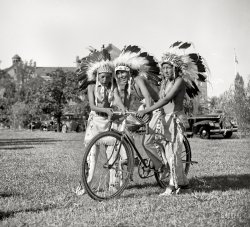
- Behind the Boardwalk: 1900
- ... this site of this great city in her heyday. When I ride my bike around AC today, I revel in the hidden bits of faded glory that still ... Posted by Dave - 07/31/2012 - 2:53pm -
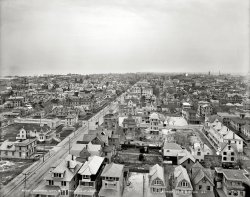
- High Roller: 1912
- ... took the farm, liquidated it (as it were) and ditched her bike for this spiffy electric runabout.
Shorpy 101 I do so enjoy ... Posted by Dave - 08/28/2012 - 10:15pm -
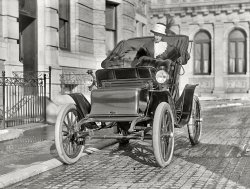
- The Nasby: 1905
- ... on that place. Geez.
A safer time for bikes Not a bike lock in sight.
Nooks and Crannies What I wouldn't give to explore ... Posted by Dave - 08/13/2013 - 3:39pm -
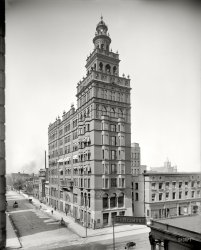
- Toy Story: 1949
- ... Roy was the real deal, when I was a lad. I was Roy, my bike was Trigger. Our dog, a Cocker Spaniel had little interest in being ... Posted by Dave - 09/26/2013 - 12:24pm -
![Toy Story: 1949 October 1949. "Cowboy entertainer Gene Autry posing with children's clothing and toys which have his name and/or image on them." Kodachrome from photos by Frank Bauman and Stanley Kubrick for Look magazine. View full size.
RoyRoy Rogers is always mentioned as the TV and movie cowboy with a plethora of marketing items for sale, but this photo proves that Gene was certainly no slouch. Kind of miss this wholesome children's entertainment. Simple stories with real morals included!
Successful BrandingThe postwar prosperity + Baby Boom + TV seems to have been quite lucrative for him--and the "Repeating Cap Pistol" pictured recently brought an eBay seller $461 after spirited bidding.
Sixty-four years laterThis picture of old familiar boy's toys and joys really takes me back to my youth when my little brother and our neighbor were both completely in awe of Gene Autry and Roy Rogers (who seemed to be featured at every weekend matinee in our small town). The neighbor was even named Gene and took his idol very seriously, owning just about all of the items pictured plus an entire bedroom suite of Autry furniture, bedspread, sheet, etc. Today, both the real Genes are gone. We all played with toy guns and none of us became murderers or even animal hunters, just pretend cowboys who kept our loved ones and property safe from all those "bad guys".
Tried the cap guns ...but never wore the jeans.
The second luckiest man in show businessGod bless Gene "Ornery". No actor, and not much of a singer, but a darn good businessman for a kid from Oklahoma! Flying A gas stations, KTLA TV, the Angels, and the Autry Museum of Western Art in LA, and I'm sure there was much more.
(In my opinion, Ringo Starr still ranks #1 luckiest.)
ViewmasterThat looks like a Viewmaster viewer at the upper right, behind a series of Viewmaster disks in their cardboard sleeves.
[It's actually a "Hollywood Toy Television," which showed short film strips of still pictures. -tterrace]
The historical star of this photo is...Eastman Kodachrome -- with due respect to Gene Autry. Sharp, rich colors combined with perfect skin tone.
Trigger fingersI'm a big Gene Autry fan but I'm disappointed he had both fingers firmly on the triggers of those cap guns. That's no way to teach gun safety to impressionable youngsters.
A quick eBay peekComics- $10-$45
Chaps- $150
Holster (w/o gun) $55
T-shirt (on left) $24.99
Spurs (w/o leather strap) $50
Scarf/bandanna-$10.50
Fan badge-$5.00
Cap gun (w/o grips) $10.00
Cap gun (w/grips) $80-$175
Watch- $30 or $175
White double holster (in red box)- $195
I found 6200 separate listings!
A few highlights shown there but not in the image:
A record player, many records, flashlights, alarm clock(NIB), dime novels, pennant, guitar, lunch boxes, LA Angels Autry autographed baseball, pen knife, Flying A horseshoe nail ring, and far too many more to list.
Enough for a museum.
Red "TV" viewerit seems to be styled after the Bakelite General Electric TV from the same year.
TV collectors (ahem) refer to this model as "The Locomotive" because it resembles the streamlined locomotives of the time.
Moppet Picture Projector
Billboard, December 31, 1949.
CHICAGO, Dec. 24. — Ray Marchbanks, regional chief for Capitol disks here, and Henry Saperstein, prexy of Hollywood Toy Television Corporation, new moppet picture projector, met last week to discuss the possibility of Cap taking over national distribution for the kid gimmick. Introduced to the market last June, the toy video set retailed at $9.95 for a red plastic case outfit that carried a four-by-three inch screen. By inserting foot-long strips of film, the child could see a six-minute show of animated cartoons. The cost of the original set included six such strips, which make a complete 30-minute movie. Saperstein has 17 story subjects, including Woody Woodpecker, Hopalong Cassidy and Gene Autry. These strips retailed for six for $1.
More Picture for MORE DollarsAccording to my Inflation Calculator, that television would cost about $2,280 in 2012 dollars (the last year available).
All that for what, two or three channels - and NO UHF stations unless you bought a separate converter.
Hoppy, Gene and RoyThough I would watch Gene and Hoppy, Roy was the real deal, when I was a lad. I was Roy, my bike was Trigger. Our dog, a Cocker Spaniel had little interest in being Bullet. My cousin, who's real name is Dale would, of course, be Dale. I had RR cap pistols, but rarely had the nickle for a box of caps. No problem, "Pow Pow" sounds were almost as good. We must have killed a thousand bad guys.
Ironically, one of my current "heroes" is, also, named Roy Rogers, the finest slide guitarist around today. His given name is RR, unlike the, late, Leonard Slye.
BTW, if you visit Los Angeles, The Autry Museum is a must see
Media Mogul1949 was also the year he sold 2.5 million copies of "Rudolph the Red-Nosed Reindeer" and the year before he came out with "Here Comes Santa Claus." The man was clearly doing something right.
(Kodachromes, LOOK, Stanley Kubrick)](https://www.shorpy.com/files/images/SHORPY_01232u.thumbnail.jpg)
- Seventh Street: 1920
- ... Liberty Lunch wagon seems familiar, as does the bike with the jacked-up handlebars.
Canvas everywhere Had I been around ... Posted by Dave - 09/13/2011 - 8:27pm -
![Seventh Street: 1920 Washington, D.C., circa 1920. "Goldenberg's, Seventh Street side." Another perspective on three places and one thing we've seen before on Shorpy. Who can link to them? National Photo Company glass negative. View full size.
Fourth familiar Shorpy thingMan in a hat - am I close?
Noon Time FriendThe "Noon Time Friend" Liberty Lunch wagon seems familiar, as does the bike with the jacked-up handlebars.
Canvas everywhereHad I been around during this time, I probably would have pursued opening a company that supplied awnings for buildings and roofs for cars. Walking inside the buildings, oilcloth coverings were on cabinets everywhere for protection. Oilcloth would have been my sideline.
On the other hand, the competition must have been tremendous.
FamiliarGoldenberg's, People's Drug and Hahn's ... ?
[Three out of four! - Dave]
Multiple Familiar ThingsBesides men in hats, ghostly images, bicycles, buggies and cars all at the curb, and trolley tracks, I seem to recall seeing the "Noon Time Friend" sandwich cart featured in a Shorpy posting before.
License PlatesWhy do you suppose that the two cars at the left each have two license plates? Is it one for Washington and another for the state of their residence at the time?
[You had to have plates for wherever your motor vehicle was operated. Many cars in Washington also had Maryland or Virginia tags. - Dave]
Peoples Store No. 1This would be The Link for the image of the Peoples Drug Store.
[Also here. And let's not forget Hahn's Reliable Shoe House.- Dave]
FamiliarThe lunch cart?
[Ding ding ding! You are correct. - Dave]
One more thing.Mold.
I would guessChestnuts roasting on the curb?
The Seven StoresWhen I was in high school in the 1940s, I worked at the Central Public Library at Seventh and K Streets, just off to the right of this scene. We always considered Goldenberg's to be a bargain department store. For example if something was cheap or looked cheap it "probably came from Goldenberg's basement." The other six department stores in D.C. were farther south on Seventh Street or farther west on F or G Streets.
Seventh Street: 1920 plus 90Here's the same view today.
The Hydrant Lives!I know I am a bit late in this (out of town). It appears to me that the fire hydrant on the corner may have outlived much of what has now been replaced.
(The Gallery, Cars, Trucks, Buses, D.C., Natl Photo, Stores & Markets)](https://www.shorpy.com/files/images/29484u.thumbnail.jpg)
- Wagons Ho: 1901
- ...
Back to the Future The bike on the porch looks out of place in a 1901 setting. It would fit into any ... Posted by Dave - 04/26/2022 - 3:46pm -
![Wagons Ho: 1901 Washington, D.C., circa 1901. "View of S.W. Block 386, probably D Street side of Baltimore & Potomac Railroad freight station at Maryland & D, 9th & 10th Streets, showing man loading freight into delivery wagon." 5x7 glass negative, D.C. Street Survey Collection. View full size.
What's in the wrappers?Are those Gatling Guns wrapped up? Sure looks like it!
(See the unwrapped version here: https://www.spanamwar.com/Gatling)
That’s some freight stationYour one-stop-shop for machine guns and whiskey!
A plug for ShorpyI was curious about Wilson Whiskey and found this ---
https://emmettwilsonbook.com/2015/08/27/his-brand/
Back to the FutureThe bike on the porch looks out of place in a 1901 setting. It would fit into any current-day setting, white sidewalls and all.
[The entire tire is white, not just the sidewall. Before manufacturers began adding carbon black around 1910, tires were the white color of natural rubber. - Dave]
(The Gallery, Bicycles, D.C., D.C. Street Survey, Horses, Kids, Railroads)](https://www.shorpy.com/files/images/SHORPY-40365a1.thumbnail.jpg)
- Buchu Buttons: 1921
- ...
A world of hurt if anyone really intends to ride a bike with a seat adjusted at such an angle.
Sporty Little Car That is a ... Posted by Dave - 08/13/2013 - 4:00pm -
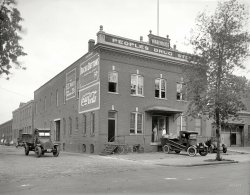
- The Kids' Table: 1940
- ... house.
Engaged Much as I am intrigued by Bike Bubba’s suggestion of the dynamic in the foreground, it appears to me ... Posted by Dave - 11/21/2018 - 10:22am -
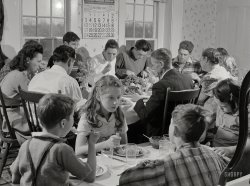
- My Eldon Christmas: 1964
- ... withdrew the funds. Getting the thing home balanced on my bike was a bit of a chore, but I had a paper carrier which made it easier.
... Posted by Vintagetvs - 09/18/2011 - 11:04pm -
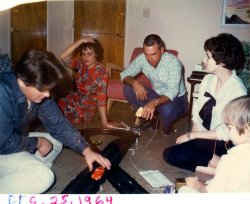
- Over the River: 1903
- ... there was so much corrosion! I also used to ride my motor bike on the pedestrian walkway down the middle of the bridge. There was a ramp ... Posted by Dave - 08/01/2012 - 5:42pm -
